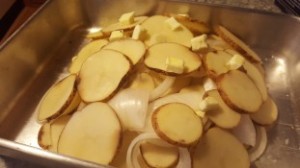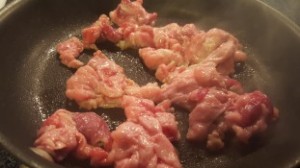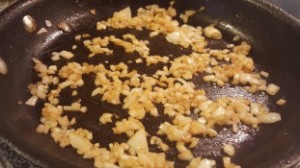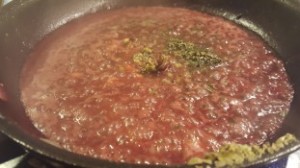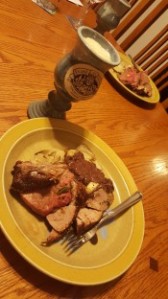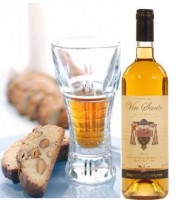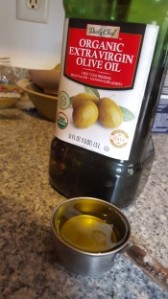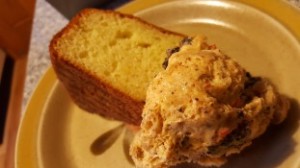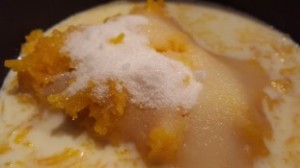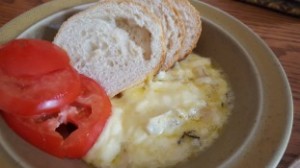The Sweet
 So my recent job, if I haven’t already mentioned, has kept my schedule notably busier and with less time to devote towards planning and developing the many recipes on my list. Doesn’t mean I’m going to stop trying to do them all, of course, it just may take much longer than I thought… though luckily it should clear up a bit more in a few months. Every now and then I get a chance to go after something small, or something cool that fits a little request… more often than not, it’s been the desserts lately. What can I say, guess I like baking and such. For this past weekend, I took about an hour to make a little bite that Buzzfeed paired with Cheese Souffle: Salted Caramel pieces.
So my recent job, if I haven’t already mentioned, has kept my schedule notably busier and with less time to devote towards planning and developing the many recipes on my list. Doesn’t mean I’m going to stop trying to do them all, of course, it just may take much longer than I thought… though luckily it should clear up a bit more in a few months. Every now and then I get a chance to go after something small, or something cool that fits a little request… more often than not, it’s been the desserts lately. What can I say, guess I like baking and such. For this past weekend, I took about an hour to make a little bite that Buzzfeed paired with Cheese Souffle: Salted Caramel pieces.
Did you know there’s an actual REASON that Salted Caramel hasn’t been used and popular until our recent 20th century? And no it’s not just because ‘modern chefs are more creative.’ In 1343, a large salt tax was put in place by King Philip VI, making it a luxury that only rich could afford. Thus even simple salted butter couldn’t be used by the masses until Brittany unified with the Kingdom of France. Even then, the ‘staple’ salt, Guerende Sea Salt, was a rather difficult ingredient to obtain [and I’ll admit, I myself just used a simple sea salt that’s in our pantry. We’ve got so many salts as it is, no reason to buy another one]. Thus the overall USE and distinction of it historically as far as pastries are concerned, a craft which focuses a lot on transforming very INexpensive ingredients, would logically take a much longer time to be realized.
In fact, that time came in the later 20th century, with Henri Le Roux, son of one of France’s most legendary pastry chefs. With his continued Swiss educated, he became France’s best chocolatier and caramel maker, ‘inventing’ the little confection midway through the 1900’s. Though it snuck in rather low on our radar, in 1980 salted butter caramel was voted the best candy in France. And now… well, now it’s the over-used dessert addition/focus that some people still use and rave over as if it was 5-8 years ago when the fad seemed to kick in.
That’s not to say it isn’t still delicious; there IS a reason it’s been so popular.
Chef’s Overdramatic Self-Centered Lecture Corner
It is often read with this particular recipe, or really ANY French recipe with such simple components as such, should really be made with the BEST of each ingredient in order for it to come out in that perfect form of buttery-salty-caramel chew. Of course, my idea on making this was rather last minute and I didn’t exactly grab everything that fit that bill. Which I actually don’t mind, since it was my first time attempting the caramel recipe and I don’t want to ruin any awesome ingredients with a minor screwup that masks everything.
 That said, I DID have a little bit of leftover Organic Can Sugar that I mixed with my regular sugar, we’ve had plenty fantastic Scottish Butter sitting in our freezer for months now, so I used some of each to help level it up decently.
That said, I DID have a little bit of leftover Organic Can Sugar that I mixed with my regular sugar, we’ve had plenty fantastic Scottish Butter sitting in our freezer for months now, so I used some of each to help level it up decently.
There’s a rather decent technique I’ve found about for this, one which makes a lot of sense. Let me start off by saying that caramel really IS quite simple; you cook the sugar until it turns color, not too much, and then add in your cream and butter. That said, one usually has to be careful adding in the cream, since he shock in temperature can make the hot liquid sugar seize up and turn solid too fast. It’s fixable, just got to slowly bring it back to temperature, but not condusive and a pain. So, as other recipes have done, one just heats up the cream on the side to a simmer, leave it warm, and add it in like so. This is also a great way to dissolve most of the salt to the mix into the caramel.
Of a quick final note, it’s very important to prepare your pan to pour the caramel in afterwards. Parchment paper works perfectly, though I’ve seen a recipe with aluminum foil too; the main key to it, however, is getting a thin layer of Vegetable Oil brushed along the bottom and sides to ENSURE that no sticking happens. Which is a pain, since with the paper already there it tends to pool. And don’t try to play with different oils unless they’re even MORE neutral in flavor; otherwise you’re getting an olive oil-flavored caramel [which actually doesn’t sound too bad if done right, but not the goal here]. I bring it up mainly since coating the knife or other cutting/handling tools for the finished candy is a great way to keep it clean and easy handling. May just want to pat with some paper towels afterwards to soak up any excess.
Salted Butter Caramels
1¾ cup Sugar
Vegetable Oil
1/3 cup Cream
¾ + tsp Sea Salt
5½ tsp Butter, cubed
1 tsp Vanilla Extract
Directions
- Place Sugar in sauce pan, moving over medium heat, stirring very often and NOT leaving the kitchen

- While this is initially heating up, quick mix the Cream and ½ tsp of Sea Salt in another pan over low heat, bringing to a simmer before removing. Keep warm

- Also, line a square baking pan with parchment paper, lightly brushing the bottom and sides with Vegetable Oil

- Stir more often as the sugar melts, making sure not to let it sit too long and burn while others are still crystallized

- When most of it’s melted, stick in a candy thermometer, continuing to stir and cook until the sugar reaches 180C [supposedly 356F]

- Briefly remove from heat and slowly, carefully add the warm cream mixture, stirring in until fully incorporated

- Return to heat until sugar has come back up to 140C [284-ish F]

- Remove from heat again, adding in Butter and Vanilla, mixing quickly until it’s thoroughly incorporated and smooth

- Pour the caramel into the parchment-lined baking pan, sprinkle the remaining sea salt over the top

- Leave to cool for about an hour or more
- Upturn onto the cutting board, taking a knife to cut into the desired piece sizes. If still rather sticky, coat the knife blade with some of the vegetable oil every now and then

- Transfer to bags, wrap in wax paper if needed/desired, and enjoy

My Thoughts
Of course it didn’t come out as I wanted. I could see even before it was fully cooled that this caramel would be much firmer than what should have been achieved; instead of that soft, stretchy, tender little chew, I got a hard and crunchy-chewy toffee-like creation. Not that I mind in general, it’s still quite delicious to suck on; creamy-buttery richness with that almost-burnt sugar mixed in. Perhaps not in a perfect blend, again not ALL the ingredients were of anything more than average/cheap quality, but it succeeded where needed. Well, it needed more salt, could only taste it IF sucking vs chewing, and then only in the fir half minute. I’m debating if it’s just the result of not using a classic big-grained French sea salt, which may have more compact flavor too, or if the recipe needed more… I blame the recipe.
As for why the sweets didn’t turn out as desired in consistency, I have two main theories. Either I may have cooked the sugar a bit hotter than called for at one or two periods, very possible though I’m pretty sure it didn’t get THAT much higher than the recipe called for, or the recipe really needs to have notably more butter and cream added into it. My money is on a combination of the two.
Possible Pairings
 Not the kind of recipe that usually comes with a whole glass of alcohol to ‘pair’ with, but assuming one DOES want to imbibe while chewing on a [properly] soft and salty-creamy piece of cooked sugar heaven, I could think of a few tasty options.
Not the kind of recipe that usually comes with a whole glass of alcohol to ‘pair’ with, but assuming one DOES want to imbibe while chewing on a [properly] soft and salty-creamy piece of cooked sugar heaven, I could think of a few tasty options.
The first thing that comes to mind is Bubbly; just a simple glass of that delightful drink that never really needs to be fully figured out as to why it tastes good with anything. Since there’s no real confining aspect to the candy that requires distinct characteristics in its partnered drink to balance out, besides the sweetness itself [the saltiness is already being handled by its own sugar content], we can revel in the option of that most celebratory of wines. A Champagne or nice Cremant de Loire/Bourgogne/Alsace wouldn’t be out of the question. The beautiful complexities of a good bottle can be easily featured under the simple candy, any toasty/buttery notes compliment the buttery/creamy aspect of the caramel, they’re even paired often with local seafood dishes so it works with the salt aspect on a secondary level. The one thing I WOULD make sure to try and do, if possible, is to get a Demi-Sec [the sweeter styles of French bubbly], just to make sure the balance is right.
 Many a sweet, fortified, and aged wine will shine here, much like the delectable muscat-based creations from the south of France. Though in this category I can’t think of anything better than a properly thick, brown, caramelly ‘Sticky’ from Australia. Or, as they’re technically known as, Tawnies, influenced by aged ports and one of the best things to ever come out of the country in my opinion.
Many a sweet, fortified, and aged wine will shine here, much like the delectable muscat-based creations from the south of France. Though in this category I can’t think of anything better than a properly thick, brown, caramelly ‘Sticky’ from Australia. Or, as they’re technically known as, Tawnies, influenced by aged ports and one of the best things to ever come out of the country in my opinion.
Of final note, any Aged Spirit would also be on my list, a-la Whiskey. The vanilla and caramel flavors picked up from the toasted oak will compliment these flavors greatly, and high-alcohol actually helps pair with various difficult food concerns. Very ‘heavy’ meals, fatty, acidic, but especially SWEET things can be cut or balanced next to a good spirit. If I had to pick one thing, though, I’d definitely have to go for a GOOD quality, special Rum. Aged well and from a proper estate, they’re flavors are amazing and encapsulate the epitome of ‘sugar’ complexities. They even make some in the French Martinique. Just saying.






